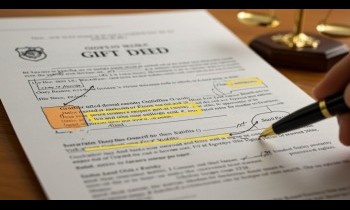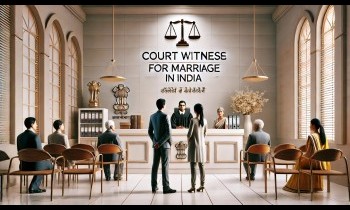Power to Examine the Accused - CRPC 313

Date : 04 Apr, 2022
Post By Vishal Kumar
Section 313- Power to examine the accused. (1) In every inquiry or trial, for the purpose of enabling the accused personally to explain any circumstances appearing in the evidence against him, the Court- (a) may at any stage, without previously warning the accused, put such questions to him as the Court considers necessary; (b) shall, after the witnesses for the prosecution have been examined and before he is called on for his defence, question him generally on the case: Provided that in a summons- case, where the Court has dispensed with the personal attendance of the accused, it may also dispense with his examination under clause (b). (2) No oath shall be administered to the accused when he is examined under sub- section (1). (3) The accused shall not render himself liable to punishment by refusing to answer such questions, or by giving false answers to them. (4) The answers given by the accused may be taken into consideration in such inquiry or trial, and put in evidence for or against him in any other inquiry into, or trial for, any other offence which such answers may tend to show he has committed. INTRODUCTION The rule of Audi Alteram Partem states that each party should be heard. No party should be condemned unheard. These principles form the basis of natural justice. These are the principles enshrined under section 313. In this section, the accused is allowed to furnish an explanation for the pieces of evidence that have been presented before him. The only catch under this section is that whatever the accused says in his defence cannot be used to convict him. The statement given by the accused under this section is not given under oath and hence the person cannot be convicted based on the statement under this section. UNDERSTANDING THE PROCEDURE UNDER SECTION 313 • This section comes into the picture after the submission of the charge sheet to the magistrate under section 173 but before the charges against the accused have been framed. The accused is called to the trial court by serving to summon him. The court after listening to the accused can also discharge him. • After hearing the accused and seeing all the evidence, the court, if satisfied that there is a prima facie case against the accused, will frame charges. It is done after the accused has been called under section 313. • Once the charges are framed, the trial starts, and the judgement gets delivered. Hence, once the trial starts, the accused cannot be discharged but can be acquitted. Discharging of the accused is only done when there is no case prima facie against the accused. But acquittal is done when there is a prima facie case against the accused but there wasn’t enough evidence against him to prove him guilty beyond a reasonable doubt. • Power of the court to examine the accused under section 313(1)(a) is discretionary. This means that even if the court does not question the accused, the accused cannot do anything about it. • Section 313 can again be invoked after the framing of charges and this time the invoking of section 313 becomes mandatory. This is mentioned under section 313(1)(b). The accused shall be heard by the court after the witnesses of the prosecution have been examined. However, hearing the accused under this sub clause is not equivalent to the defence counsel of the accused fighting the case. For example, if A is the accused and charges have been framed against him, the court after hearing the prosecution witness can generally examine the accused on the facts of the case. This does not necessarily mean that the court is asking the defence counsel to present their case on behalf of the accused. • The most important point regarding this section is that the statement given by the accused cannot be considered evidence under the Indian Evidence Act. • Even if the statement given by the accused is not correct or if the accused doesn’t answer any question under section 313, he will not be held liable and be punished for the same. • The court while asking questions has to make sure that the questions are formed clearly and logically. There should be no ambiguity in the questions. The court also has to make sure that the accused can understand everything that is being asked of him. He should understand under what circumstances he has been called to the court and the consequences of whatever he speaks in the court if any.
OBJECT OF SECTION 313 As already mentioned, listening to both parties in a case is fundamental to the delivery of justice. Justice can never be delivered by hearing one party only. The accused should be considered an equal in the eyes of law and hence should be given a chance to speak what he has in his mind regarding the evidence brought to the court against him. This object of law is enshrined under Article 313. Even though the accused is not compelled by law to speak under this section, the law nonetheless makes sure that he is at least given a chance to clear things out. It is a direct conversation that the accused strikes with the court. The importance of this direct conversation with the court is immense specifically for such people who have been falsely accused. The effect of having a direct conversation with the bearers of justice becomes automatically important while delivering justice. SECTION 313: A BOON OR BANE (DISCUSSED WITH CASE LAWS) Section 313 attempts to align itself with the principles of natural justice and it does so to quite a certain extent. However, some loopholes need discussion in this section. This part will be discussing both the good and the critical aspects of section 313 through case laws. This section is an enabling provision in the sense that it gives a chance to the accused to defend himself. While doing so, the interference from all the stakeholders such as third parties, prosecution counsel, defence counsel, witnesses, etc., stays out of the dialogue. This is based on one of the most important principles of natural justice that no party should be kept unheard of. In the case of Raj Kumar Singh vs. the State of Rajasthan, the court reiterated the importance of section 313 for delivering justice. In other cases, the courts have also focused on the point that section 313 is not just a formality that the courts have to go through. This section forms the very basis of what we call a balanced structure of justice. Hence, no court can take this section as a formality. In the case of Janak Yadav vs. the State of Bihar, the court also mentioned that section 313 is not only to deliver justice but at the same time a way to provide a safeguard to the accused from the procedure. It is a safe harbour clause of a kind for the accused. This doesn’t mean that the accused will get discharged every time his statement is recorded under this section, but the trial will be more balanced in that regard. In the case of Nar Singh vs. the State of Haryana, the court clarified that there are two ways of invoking section 313. One way is that this section can be invoked during any stage of the trial, and this is mandatory, whereas the second way is when the accused is called upon after the examination of witnesses of prosecution and this is mandatory. It is also to be kept in mind that under this section, an accused can be called multiple times for his examination because there might be different material that can come up in court which is incriminating. Hence, it becomes important that the accused be re-called for examining the same. Now, when it comes to critical aspects of this section, there are certain loopholes in the section which need attention. In a recent case of Prahlad vs. the State of Rajasthan, the accused was guilty of rape and murder of a child. The court held him guilty on many grounds. One of the grounds for holding him guilty was that he remained silent when he was asked to give explanations regarding certain evidence under section 313. This case shows that the right to remain silent which is in line with article 20(3) is still a grey area in terms of criminal jurisprudence. If a person who remains silent can be convicted for this reason, then there is no guarantee that a person who speaks while explaining this section will be spared due to lack of evidence. The right to remain silent is interpreted adversely in many cases and mostly interpreted to the prejudice of the accused. In the case of Ramnaresh and ors. v. The State of Chhattisgarh, the court mentioned that adverse inference can be drawn from the silence of the accused. The court also said that such inferences are not in violation of Article 20(3) of the Indian constitution which provides a safeguard against self-incrimination. CONCLUSION There is a lot of grey area as to the rights of the accused and the scope of the power of the court under section 313. If any one of the two falters, there is no mechanism in place to correct the same and the fault will mostly be to the prejudice of the accused. While this section is important for its natural justice inclinations in criminal jurisprudence, it also manages to be exploitative at times. A definite system of coherent rules with fewer conflicting ideologies needs to be established to clear the grey area and make it clearer. Looking for a Lawyer?
Lawtendo is a platform for you to help in hiring legal counsel. We work twenty-four hours to provide the best lawyers who suit the needs of the customers. We work with a wide range of lawyers whose areas of expertise range from divorce, court marriage, and registration, property possession delay, cheque, and money recover to will drafting and agreement, employment issues, and builder disputes. In addition to this, we also deal with cases of wrongful dishonour of cheques. Lawtendo is a hassle-free platform that works rigorously to make sure the best lawyer reaches their client in time. Written by Tarushi Goel, a fifth-year law student of O.P Jindal Global University. She is currently pursuing BA LLB and is inclined toward legal research.





